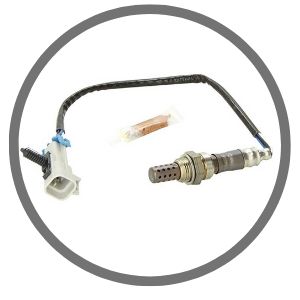Oxygen sensors play a vital role in both engine management and emissions control. When an O2 (oxygen) sensor goes bad, it’ll cause your vehicle’s engine to run less efficiently.
Typically, your car or truck will exhibit symptoms when an O2 sensor has gone bad. Or, it may exhibit none at all.
Often enough, the only sign of the problem at all is the service engine soon light being on. This is particularly true when the oxygen sensor that has gone bad is downstream of the catalytic converter.
Bad Oxygen Sensor Symptoms
The O2 sensors take the pulse of the engine. When they are not working properly there typically will be noticeable symptoms. Most of the time, the check engine light will come on. A code scanner will tell you which one has gone bad (there are different codes associated with different sensors).
The trouble codes associated with the OBDII scan will reveal which sensor is at fault and why it is bad (at least what the computer thinks is wrong). It is very rare for there to be a problem with an oxygen sensor, and not have the check engine light come on.

Here are the most common symptoms of a bad oxygen sensor in your vehicle:
1. Service Engine Soon Light
More often than not, when an oxygen sensor in your car or truck goes bad, it will throw a diagnostic trouble code. There are many oxygen sensor related codes.
These codes correspond with what side of the engine they are on (known as the “bank” for cylinder bank) and how far downstream they are. For instance, an oxygen sensor at bank 1 – sensor 1 would be:
- Bank 1– Side of the engine with the first cylinder in the firing order. This means that you need to look up the firing order for your particular make, model year, and engine.
- Sensor 1– Sensor 1 would be the first O2 sensor in the line of sensors starting with the exhaust manifold and making its way back to the exhaust pipe. An oxygen sensor that is between the catalytic converter and the engine is known as an “upstream” sensor. Oxygen sensors after the catalytic converter are “downstream sensors”. As a rule, the upstream sensor is more important for engine timing and air/fuel ratios.
By using a OBDII scanner you can determine exactly which sensor is bad, and what is wrong with it.
2. Loss In Fuel Economy
Your vehicle’s oxygen sensors are responsible for helping to keep your engine running at optimal efficiency. The engine management computer uses the data from all of the O2 sensors to keep the air/fuel mixture optimized. A bad oxygen sensor can affect the mixture greatly.
Without being able to optimize the air fuel ratio, combustion isn’t as efficient, and fuel mileage suffers. There could also potentially be raw fuel that enters the exhaust. This fuel can hurt the catalytic converter.
3. Bad Smelling Exhaust
One of the most common symptoms that an oxygen sensor has gone bad is stinky exhaust. The smell is often described as “rotten eggs” or sulfuric. Either way, like with rotten food, “the nose knows”.
4. Engine Running Rough
Without the proper air/fuel mixture, your engine won’t run as smoothly as it should. This is especially true if the mixture ends up too lean.
While a rough running engine can be a sign of a bad oxygen sensor, it is often a sign of a misfire as well.
5. Failed Emissions
Often enough, there won’t be any noticeable signs of a bad oxygen sensor. You’ll go to get an emissions check done, and your car or truck fails the test. Without a check engine light, it can be tough to lock down exactly what would cause the vehicle to fail, but oxygen sensors are one of the more common causes.
Conclusion: Bad O2 Sensor Diagnosis
There may or may not be any noticeable symptoms when your vehicle’s oxygen sensor(s) go bad. It is smart to use a scan tool to determine whether or not there is an OBD II trouble code associated with any of the sensors. Good luck diagnosing with your diagnosis.
